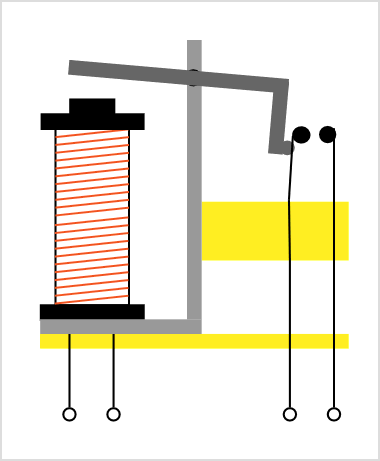If we want to control much more powerful outputs such as even larger lamps or motors we can use a relay.
A relay is just a type of switch, except that the position of the switch (on or off) is controlled by an electromagnet. When a coil is connected to a power supply it makes it work like a magnet. This magnetic field causes the contacts of the switch to pull together. The clicking noise you hear in a car when it is indicating is the sound of a relay turning on and off.
The great thing with a relay is that it also allows you to switch mains powered (230V ac) devices to be switched on and off by a low power circuit. An example of this is the standby button on a TV. You may notice that when you turn the power via the remote there is a little clicking noise in the TV, this is the relay turning on.



Normally the switch contacts are open. When the coil power supply is connected to a battery it turns into an electromagnet and attracts the metal arm. The arm then pivots and pushes the contacts together. The relay shown in the animation only has one SPST switch but relays can also contain a range of other switch types (see the switch section). The circuit symbol shown is a SPDT type.
The circuit below shows a 555 astable circuit controlling a high power, mains voltage motor. The circuit will make the motor turn on and off repeatedly at a certain rate. Even though the 555 timer works on a low voltage, the relay allows the circuit to control a much larger current and voltage for the motor.
In the circuit above you may notice that a diode has been added to the circuit too. When a coil (as in the relay) is switched off it generates a high voltage called a Back EMF which is enough to give you a small shock even. Transistors are very sensitive devices and this high voltage can damage them. Adding the clamping diode (or blocking diode as it is sometimes called) diverts the high voltage away from the transistor preventing it from being damaged.

